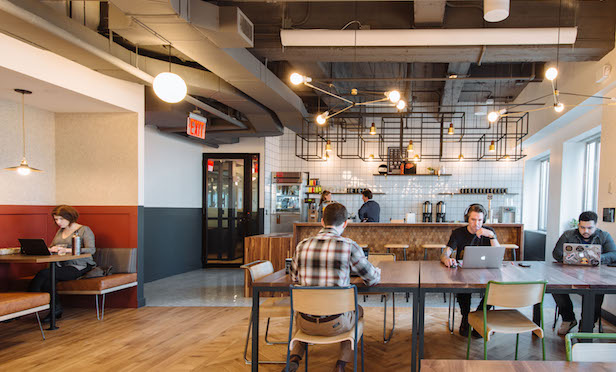 The US is home to an estimated 40 million square feet of corking space, such as this WeWork facility in Brooklyn Heights. (Photo: WeWork)
The US is home to an estimated 40 million square feet of corking space, such as this WeWork facility in Brooklyn Heights. (Photo: WeWork)
ATLANTA—The largest occupier of corporate real estate in New York City may be home to several tenants—in fact, an ever-changing universe of them. That occupier is WeWork, and its growth in recent years has been due in part to space occupiers wishing to provide flexibility to employees and in part by a desire to reduce expenses.
In fact, the latest survey of corporate real estate professionals conducted by CoreNet Global and Cushman & Wakefield finds that they’re “more concerned about property costs than ever before. More than 90% of them find total property costs an important consideration in decision making,” with 61% rating costs “extremely important.” It’s a priority most evident in the banking, financial services and insurance sector.
Although nearly half of BFSI tenants surveyed said they now prefer shorter lease terms, most space occupiers want to remain where they are, due to continued high relocation costs. Only 4% of the survey respondents want to move into lower-cost space.
Conversely, according to the CoreNet Global/Cushman & Wakefield report, relocating to more efficient and flexible workspace is being considered by most corporate real estate managers. “Besides cost savings, it also gives room to experiment with shared office settings,” the report states. “Most respondents (73%) and all three major sectors”—including technology and professional services along with BFSI—“are carefully planning for headcount growth.”
Within this continuum, “Coworking practices are gaining momentum,” says Sigrid G. Zialcita, managing director, research & investment strategy, Asia Pacific at Cushman & Wakefield. “It is fast becoming a part of the corporate culture at many organizations.”
CoreNet Global and Cushman & Wakefield surveyed 176 corporate real estate professionals for this year’s study, which focused on coworking space “because it has been the most transformational practice in the workplace in recent years.” Ninety-six percent of the survey’s respondents said they want to use space more efficiently by offering flexible working practices, while 89% want to invest in technology to enable more flexible work locations. Fifty-eight percent want to consolidate and have a smaller number of larger real estate units, 59% want to lease sort-term space and 54% want to lease space now from coworking operators. “Connectivity means that working from a specific office location every day is not critical,’ said Tim Venable, SVP at CoreNet Global. “And workers crave flexibility. Combine those factors with the fact that corporate real estate executives want to both save money and support the way that staff prefers to work, and co-working locations offer both sides enormous benefits.”
The report finds that demand for coworking spaces is growing at an average of 10% to 15% per annum across all regions, as corporate cultures embrace the concepts of shared work spaces and collaboration. In Washington, DC, for example, the amount of coworking space has doubled over the past five to six years.
“Last year alone, coworking operators leased about five million square feet in Asia Pacific,” the report states. The size of coworking stock is estimated to be highest, in the range of 40 million square feet, in the US, followed by Europe with 20 million square feet and Asia Pacific with 10 million. “As the trend gains momentum, developers are incorporating flexible working environments into building design.”

















 Copyright © 2024 ALM Global, LLC. All Rights Reserved.
Copyright © 2024 ALM Global, LLC. All Rights Reserved.